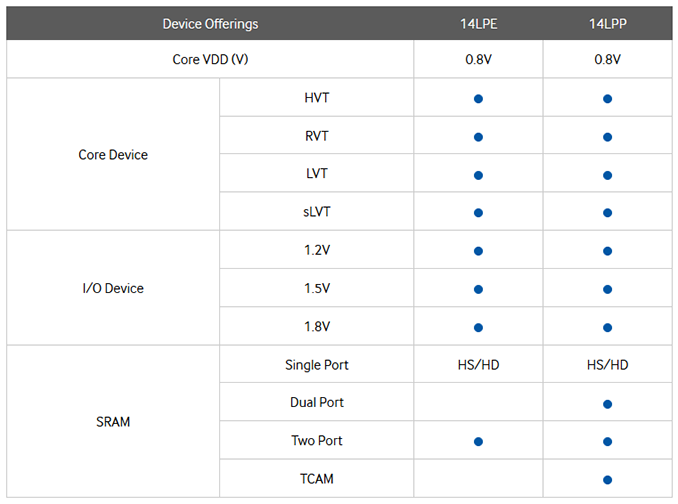GlobalFoundries and AMD Announce First 14nm FinFET Sample Production Success
by Ryan Smith on November 5, 2015 9:00 PM EST- Posted in
- CPUs
- AMD
- GlobalFoundries
- APUs
- GPUs
- fabrication
- 14nm

GlobalFoundries, AMD’s former chip manufacturing arm, is a fab that has seen some hard times. After being spun-off from AMD in 2009, the company has encountered repeated trouble releasing new manufacturing nodes in a timely process, culminating in the company canceling their internally developed 14XM FinFET process. Charting a new course, the in 2014 the company opted to license Samsung’s 14nm FinFET process, and in some much-needed good news for the company, today they and AMD are announcing that they have successfully fabbed AMD’s first 14nm sample chip.
Today’s announcement, which comes by way of AMD, notes that the fab has produced their first 14nm FinFET LPP sample for AMD. The overall nature of the announcement is somewhat vague – GlobalFoundries isn’t really defining what “successful” means – though presumably this means AMD has recieved working samples back from the fab. Overall the message from the two companies is clear that they are making progress on bringing up 14nm manufacturing at GlobalFoundries ahead of mass production in 2016.
Of particular importance in today’s announcement is the node being used; the sample chips were fabbed on 14nm Low Power Plus (LPP), which is Samsung’s (and now GlobalFoundries’) second-generation 14nm FinFET design. Relative to the earlier 14nm Low Power Early (14LPE) design, 14LPP is a refined process designed to offer roughly 10% better performance, and going forward will be the process we expect all newer chips to be produced on. So in the long-run, this will be GlobalFoundries’ principle FinFET process.

Samsung Brochure on 14LPE vs. 14LPP
AMD for their part has already announced that they have taped out several 14LPP designs for GlobalFondries, so a good deal of their future success hinges on their long-time partner bringing 14LPP to market in a timely manner. For today’s announcement AMD is not disclosing what chip was successfully fabbed, so it’s not clear if this was CPU, APU, or GPU, though with GlobalFoundries a CPU/APU is more likely. Though no matter what the chip, this is a welcome development for AMD; as we have seen time and time again with chips from Intel, Samsung, and Apple, a properly implemented FinFET design can significantly cut down on leakage and boost the power/performance curve, which will help AMD become more competitive with their already FinFET-enabled competition.
Finally, looking at the expected timetables, GlobalFoundries’ production plans call for their 14LPP process to enter the early ramp-up phase this quarter, with full-scale production starting in 2016. Similarly, in today’s announcement AMD reiterated that they will be releasing products in 2016 based on GlobalFoundries’ 14LPP process.
Source: AMD










58 Comments
View All Comments
Cliff34 - Friday, November 6, 2015 - link
I just hope they can get their chips out quickly to compete with Intel.Mugur - Friday, November 6, 2015 - link
LPP at 0.8V for Core device? Isn't it mobile territory?psychobriggsy - Friday, November 6, 2015 - link
You should look at GF's 22FDX node then - that starts at 0.4V.Andrei Frumusanu - Friday, November 6, 2015 - link
That is not the nominal VDD, 14LPE for example goes down to 575mV.looncraz - Saturday, November 7, 2015 - link
Sure, until you clock the CPU into the 4GHz range :pikjadoon - Friday, November 6, 2015 - link
Finally. Glad to hear some good news out of GloFo and AMD. Let's gooooo, competition!Minor type: *principal
soliloquist - Friday, November 6, 2015 - link
Sorry for my ignorance, but could you give a little more info on a few of the items mentioned in the article?What is 14XM FinFET process? How does it compare to this 14nm FinFET LPP that they were able to produce sample chips from?
Also what was the nature of the licensing with Samsung's 14nm FinFET? How similar is this GloFo 14nm process to Samsung's 14nm process? What are the differences?
Intel999 - Friday, November 6, 2015 - link
14XM finfet no longer exists. Global Foundries failed to make it work. In desperation, they licensed Samsung's 14 nm finfet process in order to not screw over AMD for the umpteenth time by being late to market.Idk the details of the licensing agreement, but I assume Glofo pays Samsung a fee for each wafer produced plus any fees for Samsung on site training, engineering, etc.
soliloquist - Saturday, November 7, 2015 - link
Did some digging:As for 14XM vs Samsung 14nm LPP:
GlobalFoundries confirms that this news means the end of the road for its own 14XM process. The firm says Samsung's process tech has two key advantages over 14XM. Samsung's tech is further along in development, so the schedule is more attractive, and Samsung's 14-nm FinFET tech provides better area scaling by cramming more gates into a given area.
As for the licensing agreement:
GlobalFoundries will so closely implement Samsung's technology that the two partners are once again talking about portability between fabs. Through a proven level of fab synchronization never previously achieved outside of a single company, Samsung and GLOBALFOUNDRIES will use a coordinated copy-smart approach involving materials, process recipes, integration and tools. The company will also run fab-sync test chips on a regular basis to ensure that the fabs are using the 14nm FinFET process exactly the same.
mdriftmeyer - Saturday, November 7, 2015 - link
You read like your handle: Intel. Your crapping yourself because AMD's Fab 8 is exceeding their goals. Last you want is for them to have Apple and AMD full throttle. Intel's days as dictating the industry, like Microsoft, are over.